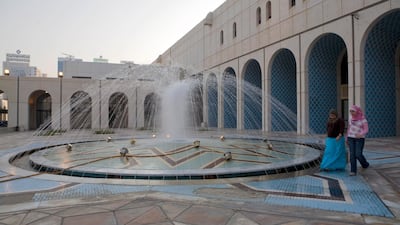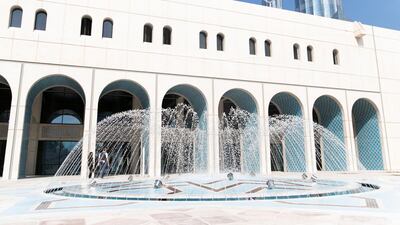Across the high-ceilinged entrance hall of Abu Dhabi's Cultural Foundation, the sound of a grand piano rings out. It comes from Julia Podsekaeva, who used to play from the first-storey balcony at the Foundation throughout the day, so there would be music to be heard.
Podsekaeva and the piano moved to the National Theatre during the interval when the Foundation was closed, but now, they are back, and so too – to the joy of many in Abu Dhabi – is the Cultural Foundation.
From its establishment in 1981 to its closing in 2008, the Cultural Foundation was the heart of Abu Dhabi.
'It was whatever you wanted it to be'
It was a social site as well as the main – if not the only – venue in town for arts, theatre, and literature. In all the stories I've reported, I've encountered few subjects that have sparked such passion. One woman, Muhra Al Muhairi, came to meet me with a scrapbook from her exhibition there that she had saved for 20 years.
People have told me stories of the gargantuan book fair, held in the garden under a tent, with stalls creeping up the stairways in the building; school graduations held in the 600-person theatre space; screenings of Emirati short films; spoken word poetry nights; Syrian and Palestinian theatre groups; piano and art lessons; poetry and cinema magazines; and discussions, discussions, discussions in the cafe and informal majlis.
“It was whatever you wanted it to be, that was the best part of it,” says Bana Kattan, who grew up in Abu Dhabi and is currently a curatorial fellow at the Museum of Contemporary Art in Chicago. “It felt like an artists-run community space. It was so accessible and approachable.”
The site, located on the Qasr Al Hosn block, had two main components: the National Library on one side, and on the other, a hall that was used for theatre and dance performances, film screenings, and literary discussions. The main entry plaza was used for exhibitions, such that people would walk through the shows to get to the other areas of the building and parking was easy.
The Cultural Foundation also served a social role. Many recall simply going there each weekend, regardless of what was on there, or organising their schedule around its offerings. “Arabic music Thursdays was on the last Thursday of the month,” recalls Kinda Suleiman, whose father, the Syrian writer Nabil Suleiman, would give lectures at the Foundation.
“It would bring all of these amazing Arabic singers like Wardah and Sabah Fakhri – all for free. Everyone knew it was the last Thursday of the month so you would plan your month around it.”
It was also, by all accounts, a place of demographic openness. “It felt intuitively Arabic, but the Foundation supported the general community,” says Kattan. “It was just dependent on who was activating it.”
Suleiman concurs: “It was everybody: Hindi, Pakistani, Emirati, non-Emiratis, Europeans.”
As the only theatre in Abu Dhabi, it played host to high culture as well as more homegrown needs, such as school graduation ceremonies and end-of-term gymnastics productions. Kattan recalls being part of a dance team made up of a group of friends. “We were so unprofessional, we used to practice in a children’s nursery after hours – and yet we were given access to the main performance hall for our final show.”
The Foundation hosted dignitaries when they came to Abu Dhabi, with cultural activities planned to accompany them. When Omar Al Bashir, the president of Sudan, visited, the Cultural Foundation mounted the archaeological exhibition Treasures of Sudan. Around 4,000 Sudanese people turned up to see it on opening day, nearly overwhelming the organisers. The ambassadors’ wives would also host an international day every year, where each community would band together to make and sell food and crafts from their country in order to raise money for charity.
The key figures in its programming
Mohamed Al Mazrouei, who is now one of the best-known Emirati artists, was tapped by the Cultural Foundation’s first director, Mohammed Ahmed Khalifa Al-Suweidi, to be a cultural animator, planning activities with cinemas, theatre, literature, publishing and exhibitions.
He recalls being so excited about the work they were doing that he would sleep in the office. “So as not to waste time,” he says. “The Cultural Foundation represents the lung and the escape to many intellectuals, students and members. In one moment, there was more than one opening ceremony of exhibitions, cinemas, theatre, and functions. It wore out many employees who did not bond with culture; however, for most of us, it was a source of joy and beauty.”
Another key figure in the programming was Huda Khamis Kanoo, who founded the Abu Dhabi Music and Arts Foundation, and who would work with the community to put up different projects. Mohammed Khalaf Al Mazrouei, known as Abu Khalaf, became director of the Abu Dhabi Authority for Culture and Heritage when it was established in 2006. He helped to step up cultural events around the city in line with the new Abu Dhabi 2030 vision, bringing in Abu Dhabi Classics and the Middle Eastern Film Festival. ADACH had its offices in the building and ran events around the city, particularly at the then-new Emirates Palace.
The Foundation closed 10 years ago for renovations that were repeatedly stalled. Reportedly, it was at one point slated for demolition, but Sheikha Maryam bint Mohammed bin Zayed, daughter of the Crown Prince, personally interceded. Of all the elements of the new Qasr Al Hosn, it is closest to the original, with its fountain, high arches, and wooden latticework ceiling feeling authentically Abu Dhabi of a certain era. Though 1981 might not feel like ancient times, in Abu Dhabi, the detail that Sheikh Zayed himself ordered the tiles from Morocco feels positively historic. If you look carefully, I was told, they each have a small hole in them that has enabled them to stay up in the heat; otherwise, their size would shift too much.
'More than learning, it gave you opportunities'
The opening art show looks back to this past. Maya Allison, director of the NYUAD Art Gallery, together with artist and curator Alia Zaal Lootah, explores the work exhibited and produced by visual artists. "The Cultural Foundation was the main meeting points for artists when they travelled to Abu Dhabi," she says. "And it was where all Abu Dhabi artists would have had their first exhibition."
It was also a key site for community artists, particularly through Al Marsam Al Hor, the workshops in which painting and photography, pottery and calligraphy were taught. Al Muhairi, who took photography there in her teens, has saved the news clippings about the final show of work by the students and teachers. Now a mother of four, she proudly reports that Al Suwaidi, the Cultural Foundation head, as well as a poet, chose one of her photographs for a book cover. “That’s what the Cultural Foundation gave you,” she says. “More than learning, it gave you opportunities. You could be in an exhibition, in a competition. You felt like someone was adopting you.”
___________________
Read more:
Your guide to Qasr Al Hosn's opening week of festivities
Neighbourhood Watch: The historic heart of Al Hosn beats again
Qasr Al Hosn and the Cultural Foundation: what you need to know
___________________
There are changes to the new Cultural Foundation, though. It will play more of a role for tourism, and its programming will be entirely directed by the Department of Culture and Tourism (DCT), rather than the more community-led approach it had before – Manarat Al Saadiyat is now positioning itself as a community centre, though it does not have the advantage of being in the centre of town. There is also more space given over to the visual arts in the new Cultural Foundation. That field’s profile has increased while that of theatre – a mainstay of the previous Cultural Foundation – has declined. The raised, enclosed booths that used to house translators in the lecture halls are now, for example, repurposed as intimate viewing rooms in which to look at works on paper in Allison and Lootah’s exhibition.
DCT has plans to activate the space for the community: it will host the Marsam Al Hor workshops again, as well as the children’s library, residencies, and a literary discussion group dedicated, in the first year, to the novels that have been listed for the Arabic Booker or the Sheikh Zayed Book Award.
But for many in Abu Dhabi, the sheer fact of its opening is cause enough for celebration. “I wish for my daughters the Cultural Foundation,” says Al Muhairi. “It was a place of belonging.”
The Cultural Foundation, in the Qasr Al Hosn block on Abu Dhabi island, is open 10am-8pm Saturdays to Thursdays, and 12pm-10pm on Fridays







